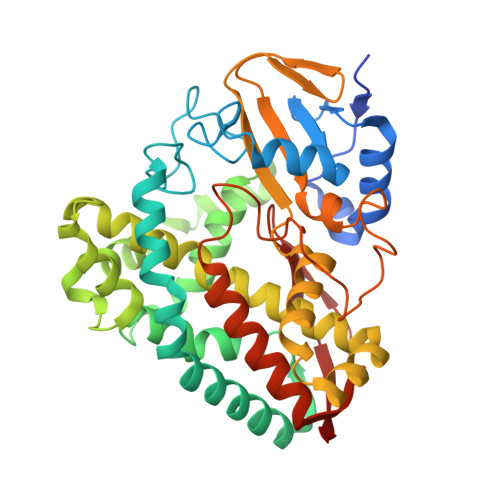Investigation of the requirements for efficient and selective cytochrome P450 monooxygenase catalysis across different reactions.
Podgorski, M.N., Coleman, T., Chao, R.R., De Voss, J.J., Bruning, J.B., Bell, S.G.(2019) J Inorg Biochem 203: 110913-110913
- PubMed: 31759265
- DOI: https://doi.org/10.1016/j.jinorgbio.2019.110913
- Primary Citation of Related Structures:
6PQ6, 6PQD, 6PQS, 6PQW, 6PRR, 6PRS - PubMed Abstract:
The cytochrome P450 metalloenzyme (CYP) CYP199A4 from Rhodopseudomonas palustris HaA2 catalyzes the highly efficient oxidation of para-substituted benzoic acids. Here we determined crystal structures of CYP199A4, and the binding and turnover parameters, with different meta-substituted benzoic acids in order to establish which criteria are important for efficient catalysis. When compared to the para isomers, the meta-substituted benzoic acids were less efficiently oxidized. For example, 3-formylbenzoic acid was oxidized with lower activity than the equivalent para isomer and 3-methoxybenzoic acid did not undergo O-demethylation by CYP199A4. The structural data highlighted that the meta-substituted benzoic acids bound in the enzyme active site in a modified position with incomplete loss of the distal water ligand of the heme moiety. However, for both sets of isomers the meta- or para-substituent pointed towards, and was in close proximity, to the heme iron. The absence of oxidation activity with 3-methoxybenzoic acid was assigned to the observation that the CH bonds of this molecule point away from the heme iron. In contrast, in the para isomer they are in an ideal location for abstraction. These findings were confirmed by using the bulkier 3-ethoxybenzoic acid as a substrate which removed the water ligand and reoriented the meta-substituent so that the methylene hydrogens pointed towards the heme, enabling more efficient oxidation. Overall we show relatively small changes in substrate structure and position in the active site can have a dramatic effect on the activity.
Organizational Affiliation:
Department of Chemistry, University of Adelaide, Adelaide, SA 5005, Australia.
















